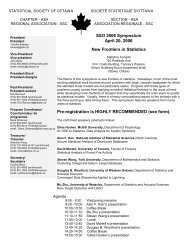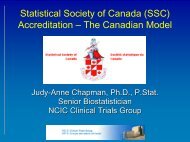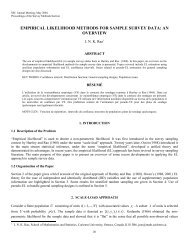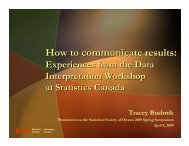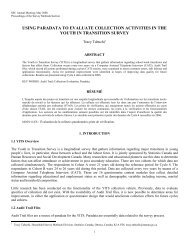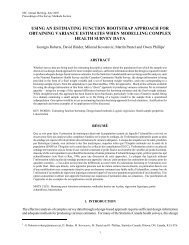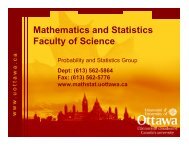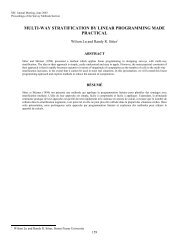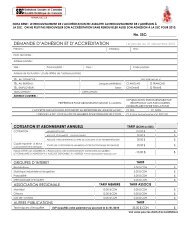Programme et résumés (pdf) - Société statistique du Canada
Programme et résumés (pdf) - Société statistique du Canada
Programme et résumés (pdf) - Société statistique du Canada
You also want an ePaper? Increase the reach of your titles
YUMPU automatically turns print PDFs into web optimized ePapers that Google loves.
Mercredi 31 mai • Wednesday, May 31, 10:30–12:00 153[MS-190]A Classical Goodness-of-fit Test Based on Fuzzy Random VariablesUn test classique d’ajustement basé sur des variables aléatoires flouesMaria GIL, Gil GONZALEZ-RODRIGUEZ & Ana COLUBI, Universidad de Oviedo, SpainIn a previous paper a class of characterizing fuzzyrepresentations of a random variable has been in-Dans un article précédent, nous avons intro<strong>du</strong>it des représentationsfloues d’une variable aléatoire. Une représentatro<strong>du</strong>ced.Each fuzzy representation corresponds tion floue est une variable aléatoire floue (au sens de Puri <strong>et</strong>to a fuzzy random variable (in Puri and Ralescu’s Ralescu) dont la valeur de l’espérance (floue) caractérise lasense) whose (fuzzy) expected value characterizes distribution de la variable aléatoire originale.the distribution of the original random variable. Le problème <strong>du</strong> test pour un échantillon des hypothèses bi-The problem of the one-sample testing of the two- latérales sur l’espérance d’une variable aléatoire floue a étésided hypothesis about the mean of a fuzzy random traité en détail dans un autre article.variable has been also discussed in depth in another La combinaison de ces deux instruments nous con<strong>du</strong>it àpaper.l’obtention de tests d’ajustement pour variables aléatoires àBy combining both tools, classical goodness-of- valeurs réelles. Les premières études empiriques ont monfittests for real-valued random variables can be tré des résultats encourageants lorsqu’on les compare à ceuxdeveloped. The first preliminary empirical stud- des tests d’ajustement habituels.ies show a suitable behavior when compared withwell-known m<strong>et</strong>hods.Session 10E Mercredi 31 mai • Wednesday, May 31, 10:30–12:00 SSC2024Case Study II: Obstructive Sleep ApneaÉtude de cas II : L’apnée obstructive <strong>du</strong> sommeilSession 10F Mercredi 31 mai • Wednesday, May 31, 10:30–12:00 SSC3026Time SeriesSéries chronologiques[MS-191]Variable Selection in Generalized Linear Models by Empirical LikelihoodSélection de variables par la vraisemblance empirique dans un modèle linéaire généraliséAsokan MULAYATH VARIYATH, Bovas ABRAHAM & Jiahua CHEN, University of WaterlooVariable selection is an important topic widely discussedin the statistical literature. The main objectiveof variable selection is to identify the leastnumber of covariates that explain the response variableappropriately. There are many variable selectionproce<strong>du</strong>res such as AIC, BIC, cross validation.The information based criteria such as AICand BIC often need a well defined param<strong>et</strong>ric likelihood.In generalized linear models, however, thelikelihood is usually not well defined. In this context,we propose to use the empirical likelihoodbased AIC and BIC for the purpose of model selection.A sub-model in GLM is defined by s<strong>et</strong>tingLa sélection de variables est un suj<strong>et</strong> important très présentdans la littérature <strong>statistique</strong>. L’objectif principal de la sé-lection de variables est d’identifier le plus p<strong>et</strong>it nombre decovariables expliquant adéquatement la variable réponse. Ilexiste plusieurs procé<strong>du</strong>res de sélection de variables, commele AIC, le BIC <strong>et</strong> la validation croisée. Les critères AIC <strong>et</strong>BIC, basés sur l’information, nécessitent souvent une vrai-semblance paramétrique bien définie. Sous des modèles li-néaires généralisés, cependant, la vraisemblance n’est géné-ralement pas bien définie. Dans ce contexte, nous proposonsl’utilisation <strong>du</strong> AIC <strong>et</strong> BIC basés sur la vraisemblance em-pirique afin de sélectionner le modèle. En MLG, un sous-modèle est défini en fixant certains coefficients de régres-SH = Somerville House SSC = Social Science Centre UC = University College



